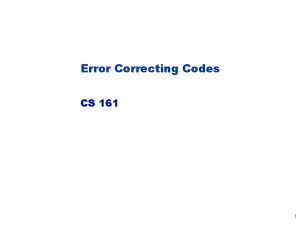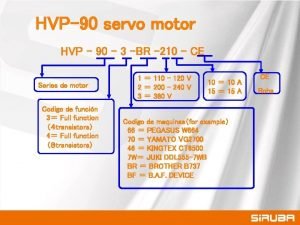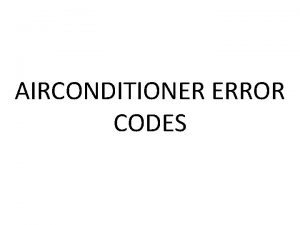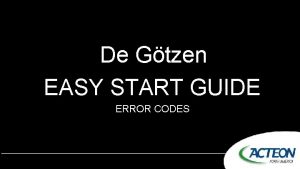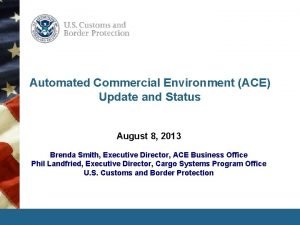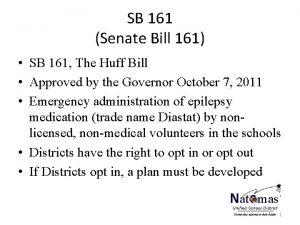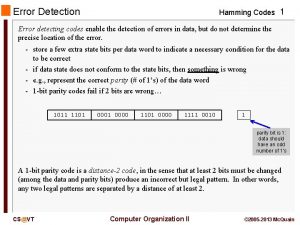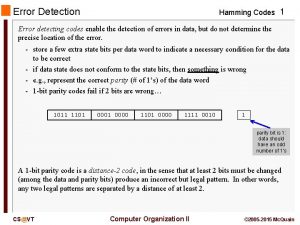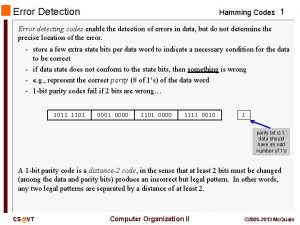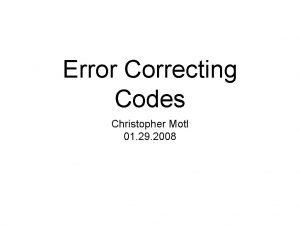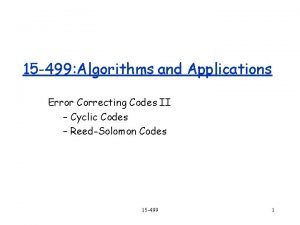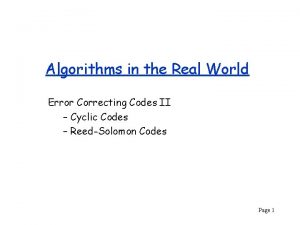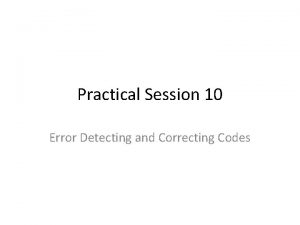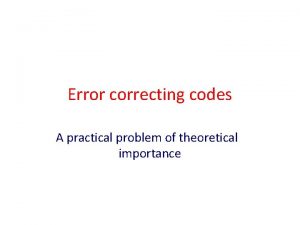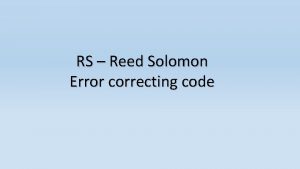Error Correcting Codes CS 161 1 why error






![Hamming code [7, 4] ■ Simplest Hamming code: ■ ■ ■ 4 bits of Hamming code [7, 4] ■ Simplest Hamming code: ■ ■ ■ 4 bits of](https://slidetodoc.com/presentation_image_h/341ea449c51ead4a8713beddabd1cf65/image-7.jpg)
![Hamming code [8, 4] ■ Add a parity bit to the whole code word Hamming code [8, 4] ■ Add a parity bit to the whole code word](https://slidetodoc.com/presentation_image_h/341ea449c51ead4a8713beddabd1cf65/image-8.jpg)
![encoding SECDED ■ Hamming code [12, 8] ■ ■ can achieve Single Error Correction encoding SECDED ■ Hamming code [12, 8] ■ ■ can achieve Single Error Correction](https://slidetodoc.com/presentation_image_h/341ea449c51ead4a8713beddabd1cf65/image-9.jpg)
![SECDED table [12, 8] 1 2 3 4 5 6 7 8 9 10 SECDED table [12, 8] 1 2 3 4 5 6 7 8 9 10](https://slidetodoc.com/presentation_image_h/341ea449c51ead4a8713beddabd1cf65/image-10.jpg)






- Slides: 16

Error Correcting Codes CS 161 1

why error correcting codes ■ noise in communication channels causes errors ■ ■ wires in circuits can act like antennas ■ ■ e. g. Wi. Fi, Bluetooth, etc. sent: 0011 0010 1101 received: 0010 0110 1101 electromagnetic radiation becomes digital data single event upset (SEU) ■ ■ cosmic particles collide with atoms in atmosphere, create showers of ionized particles (neutrons, protons), these can discharge transistors. the smaller the transistor geometry, the lower the energy needed to keep its state COMPUTER SCIENCE &ENGINEERING 2

the Hamming SEC code ■ Hamming distance ■ ■ ■ Number of bits that are different between two binary strings Hd (a, b) = population count (a XOR b) General case (non binary): edit distance ■ Given two strings of equal length, it is the minimum number of substitutions required to change one strings into another: ■ sent OHLALA! ■ received OHLALU! ■ edit distance = 1 COMPUTER SCIENCE &ENGINEERING 3

parity ■ to binary strings of size n (word), ■ add one extra bit (parity bit) such that the number of 1’s is always even (even parity) ⇒ the Hamming distance between any two correct words is 2 ⇒ if a word has an odd number of 1 s, one of its bits is in error we cannot tell which one though ■ Minimum distance = 2 ■ ■ ■ provides single bit error detection (parity code) Minimum distance = 3 ■ provides single error correction, 2 bit error detection COMPUTER SCIENCE &ENGINEERING 4

parity bit - SED ■ Parity bit ■ ■ ■ is an additional bit set to make the number of 1 s even (or odd) in that word it is a Single Error Detection (SED) mechanism. in case of an error, the data is re-transmitted or re-fetched from memory. 7 -bit data #1 s 8 -bits with parity even odd 0000000 0 00000001111 4 00011110 00011111 0000111 3 00001111 00001110 1111111 7 11111110 COMPUTER SCIENCE &ENGINEERING 5

parity checking generating a parity bit b 0 b 1 b 2 b 3 b 4 b 5 b 6 b 7 p b 0 b 1 b 2 b 3 b 4 b 5 b 6 b 7 ∑ checking the parity p ∑ check bit error if check bit != 0 two or an even number of errors are not detected COMPUTER SCIENCE &ENGINEERING
![Hamming code 7 4 Simplest Hamming code 4 bits of Hamming code [7, 4] ■ Simplest Hamming code: ■ ■ ■ 4 bits of](https://slidetodoc.com/presentation_image_h/341ea449c51ead4a8713beddabd1cf65/image-7.jpg)
Hamming code [7, 4] ■ Simplest Hamming code: ■ ■ ■ 4 bits of data (d 1: d 4) and 3 parity bits (p 1: p 3) [7, 4] means total 7 bits, data is 4 bits each parity bit covers 3 data bits the Hamming distance of every encoded word is now 3 so it is possible to detect and correct a single error but the decoder cannot distinguish between a single-bit error of a code word and the double-bit error of another code word COMPUTER SCIENCE &ENGINEERING 7
![Hamming code 8 4 Add a parity bit to the whole code word Hamming code [8, 4] ■ Add a parity bit to the whole code word](https://slidetodoc.com/presentation_image_h/341ea449c51ead4a8713beddabd1cf65/image-8.jpg)
Hamming code [8, 4] ■ Add a parity bit to the whole code word of the [7, 4] ■ ■ increases the Hamming distance to 4 allows SEC/DED ■ (i. e single error correction or double error detection) COMPUTER SCIENCE &ENGINEERING 8
![encoding SECDED Hamming code 12 8 can achieve Single Error Correction encoding SECDED ■ Hamming code [12, 8] ■ ■ can achieve Single Error Correction](https://slidetodoc.com/presentation_image_h/341ea449c51ead4a8713beddabd1cf65/image-9.jpg)
encoding SECDED ■ Hamming code [12, 8] ■ ■ can achieve Single Error Correction (SEC) and Double Error Detection (DED) To calculate Hamming code: ■ ■ ■ Number bits from 1 on the left All bit positions that are a power 2 are parity bits Each parity bit covers certain data bits: ■ ■ ■ Bit 1 (0001) for bits (1, 3, 5, 7, 9, 11, …): XXX 1 Bit 2 (0010) for bits (2, 3, 6, 7, 10, 11, 14, 15, …): XX 1 X Bit 4 (0100) for bits (4 -7, 12 -15, 20 -23, …): X 1 XX Bit 8 (1000) for bits (8 -15, 24 -31, 40 -47, …): 1 XXX Note that each bit is covered by two or more parity bits. Set parity bits to create even parity for each group. COMPUTER SCIENCE &ENGINEERING 9
![SECDED table 12 8 1 2 3 4 5 6 7 8 9 10 SECDED table [12, 8] 1 2 3 4 5 6 7 8 9 10](https://slidetodoc.com/presentation_image_h/341ea449c51ead4a8713beddabd1cf65/image-10.jpg)
SECDED table [12, 8] 1 2 3 4 5 6 7 8 9 10 11 12 p 1 p 2 d 1 p 4 d 2 d 3 d 4 p 8 d 5 d 6 d 7 d 8 data p 1 p 2 p 4 p 8 encoded data COMPUTER SCIENCE &ENGINEERING

decoding SEC (12, 8) ■ Value of parity bits indicates which bits are in error ■ ■ ■ Use numbering from encoding procedure Textbook example: value = 10011010 (8 bits) Encoded value = 011100101010 (12 bits: 8 data + 4 parity) ■ ■ Parity bits = 0110 indicates no error Assume bit 3 is flipped: 0101010 ■ Compute the new parity bits: ■ ■ ■ P 1 - (bits 1, 3, 5, 7, 9, 11: 0, 0, 0, 1, 1, 1), Should be 1. ERROR P 2 - (bits 2, 3, 6, 7, 10, 11: 1, 0, 0, 1). Should be 0. ERROR P 4 - (bits 4 -7, 12: 1, 0, 0, 1, 0). CORRECT P 8 - (bits 8 -12: 0, 1, 0). CORRECT Parity bits 1 and 2 are in error, 1+2 = 3 ← the bit in error COMPUTER SCIENCE &ENGINEERING 11

example data p 1 p 2 p 4 p 8 encoded data 1 2 3 4 5 6 7 8 9 10 11 12 p 1 p 2 d 1 p 4 d 2 d 3 d 4 p 8 d 5 d 6 d 7 d 8 0 0 0 1 1 1 1 0 1 COMPUTER SCIENCE &ENGINEERING 1 1 0 0 0 1 0

example (2) ■ Assume bit 3 is flipped ■ ■ bits 1 and 2 are incorrect 1+2 = 3, the bit position in error encoded data p 1 p 2 p 4 p 8 1 2 3 4 5 6 7 8 9 10 11 12 p 1 p 2 d 1 p 4 d 2 d 3 d 4 p 8 d 5 d 6 d 7 d 8 0 1 0 1 0 1 0 0 0 0 1 1 1 0 0 1 0 COMPUTER SCIENCE &ENGINEERING 1 0 0 0 1 13

SEC/DEC code ■ ■ ■ Add an additional parity bit for the whole word (pn) Make Hamming distance = 4 Decoding: ■ Let H = SEC parity bits ■ ■ ■ H even, pn even, no error H odd, pn odd, correctable single bit error H even, pn odd, error in pn bit H odd, pn even, double error occurred Note: ■ ECC DRAM uses SEC/DEC with 8 bits protecting each 64 bits, they are 72 -bits wide COMPUTER SCIENCE &ENGINEERING 14

SEC generalization ■ ■ ■ Let p number of parity bits, d number of data bits p parity bits can cover from 1 to (2 p– 1) total bits there are (p+d) possible bit errors and 1 case of no error so 2 p >= p+d+1 p d total bits name 2 1 3 Hamming(3, 1) 3 4 7 Hamming(7, 4) 4 11 15 Hamming(15, 11) 5 26 31 Hamming(31, 26) so p bits provide SEC for (p+d) bits, 2 one bit adds DED, so we p - p more p -1 2 p - 1 get SEC/DED COMPUTER SCIENCE &ENGINEERING d= 8 p= 4 16 15 5

example ■ Min number of parity bits to protect a 128 -bit word using the SEC/DED? ■ 9 bits. How? COMPUTER SCIENCE &ENGINEERING 16
 Error 161
Error 161 Pictures
Pictures Don't ask why why why
Don't ask why why why High pressure protection error
High pressure protection error Skl cik
Skl cik Hvp 90 error codes
Hvp 90 error codes Taski service tool download
Taski service tool download Sap error codes and solutions
Sap error codes and solutions Galanz air conditioner problems
Galanz air conditioner problems Good documentation practices examples
Good documentation practices examples Xgenus error codes
Xgenus error codes Ind560 plc interface manual
Ind560 plc interface manual Migatronic error codes
Migatronic error codes Specialized nutrition support
Specialized nutrition support Ims error codes
Ims error codes Automated commercial environment software
Automated commercial environment software Recognizing parallel structure
Recognizing parallel structure
